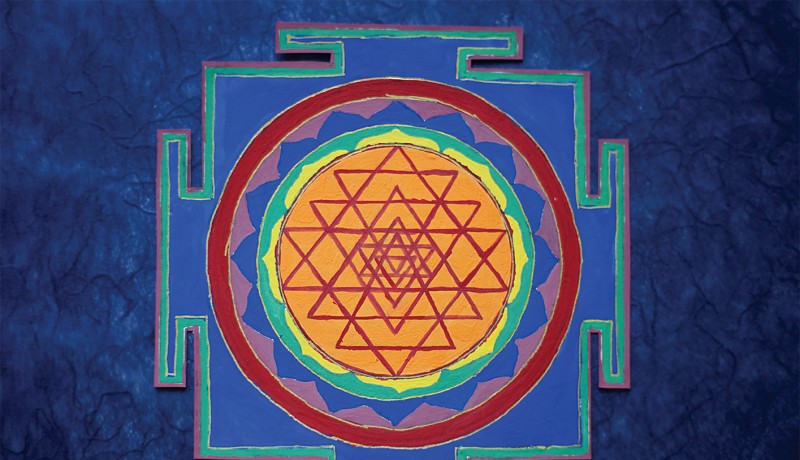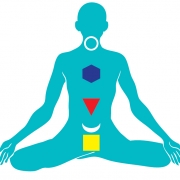
Columns

Shameem Akthar explores the link between art therapy and yoga.
Art therapy has gained its own momentum. In the adult hobbies section of bookstores in the West, colouring books are increasingly assuming pride of place.
In this wave of self-healing through art, Zentangles offer an added spiritual connotation. These modern-day self-healing therapies are gaining different expressions daily. You have colouring books that focus on one colour, colouring books with distinct topics, mandala (translated to mean a circle, but denoting infinity and radial expansion) workbooks and mandala kits…the list is endless and growing, fusing into other art therapies.
Yoga’s own branch of art therapy is that of the yantra. Somewhere in the more recent past, yantras were being done by experts and sold to those seeking relief for certain personal problems, including spiritual ones. But originally, it appears yantras were actually drawn by the sadhaka (practitioner) as a healing art, with guidance being offered by the expert. In this original yogic model, they were empowering and offered relief.
Yantras include colours (from the rainbow spectrum) and sacred geometry, shapes that establish a certain type of mindset. Interestingly, the modern aspects of ergonomics, architecture, interior decorations, even advertising, are finding out that there is a deep biological response to these that is so primitive as to reach the subconscious in a powerful way. When manipulated to act in our favour, they offer conclusive healing.
The best authors on the topic of yogic yantras are master Swami Satyananda and Harish Johari. According to the former, these are based on the idea of the individual self being a hologram of the entire cosmos. It is believed that corralling the mind back to this perspective, through the hardwiring of geometric shapes and colours and our responses to them, helps us through crises in our life, including ill health. So, the modern-day art therapies that deal with colours, geometric shapes and doodling work around this premise.
Yogic moves
Panchatattwa dharana (focus on the five elements)
In yoga’s tantric practice, you can mentally draw your geometric shapes in a meditation called panchatattwa dharana (focusing on the five elements). The geometric shapes are representative of the widely accepted elements in nature and said to have qualities that represent these elements. Sit in any meditative posture. (This may be done lying down for those with health issues.) Visualise the shapes suggested below, taking your time to fully create the shape and colour of the object at the body part mentioned. Dissolve the image of that shape before moving on the next one. A yellow square in the groin area represents the earth elements, its four corners representing the stolidity of the earth and thus creating a sense of stability and grounding. The water element, at the tailbone, may be visualised as a silver moon. Visualising cools the mind and allows the idea of water and its flow as creative energy. At the navel centre, a red triangle creates the burning fire, whose energy is purifying and transforming. At the heart, the air element may be visualised as a blue-grey hexagon. This suggests the idea of expansion, lifts the spirit and moves it away from dullness and lethargy. At the throat, you may visualise its element of ether, as an empty circle pulsing with myriad lights. The element of ether is expansive, unafraid. You may do this for a few minutes a day, taking your time to savour the images and their colours. Benefits: This helps focus the mind and shift perspective, aiding with problem-solving. It also helps with pain relief and encourages self-healing.
Mandukya Upanishad
It is said to be the shortest of the Upanishad but is listed with the best. It is said that Lord Rama had suggested that only Mandukya was sufficient to understand all the yogic truth. The beauty of this treatise is that it is written by an author who has understood the yogic secret. It is at once a sharing of his experience and an instructional manual. It compacts the truth into the ancient syllable Om and examines the different states of consciousness through the four aspects of this syllable. When you read this Upanishad, if you are a serious sadhaka, you are likely to feel the goosebumps of a soul that understands the secret code. The words are abstruse for those who do not have a glimmer of what yoga is really about. But for those who have what is called mumukshutva (deep spiritual yearning) it resonates with a powerful message. Though a lot of scholarly ink has no doubt been shed on this amazing treatise, the experience of reading a pure translation and relating to it is the most powerful experience of this Upanishad. It leaves theory and transcends into experience. Here is a quote that puts a cap on this mind-shifting experience: The fourth is soundless: unutterable, a quieting down of all relative manifestations, blissful, peaceful, non-dual. Thus, OM is the Ātman, verily. He who knows thus, merges his self in the Self – yea, he who knows thus.
Shameem Akthar is a Mumbai-based yoga acharya. If you have any queries for her, mail us or email at contact.us@harmonyindia.org (Please consult your physician before following the advice given here
Photographs by iStock Featured in Harmony — Celebrate Age Magazine December 2016
you may also like to read
-
Mental workout
Mukul Sharma tells you how to keep those grey cells ticking Everyone will ultimately lose his or her brain….
-
Helpline
Dr Harshbir Rana answers your queries on personal and social issues related to ageing, elder care and intergenerational relationships ….
-
Off the cuff
Raju Mukherji pays tribute to his first hero, Tenzing Norgay, an exemplary mountaineer Darjeeling, 1955. Dr ‘Pahari’ Guha Mazumdar….
-
Yoga RX
Shameem Akthar shows ways to control debilitating ankle pain through regular practice Ankle pain is so common and prevalent….









